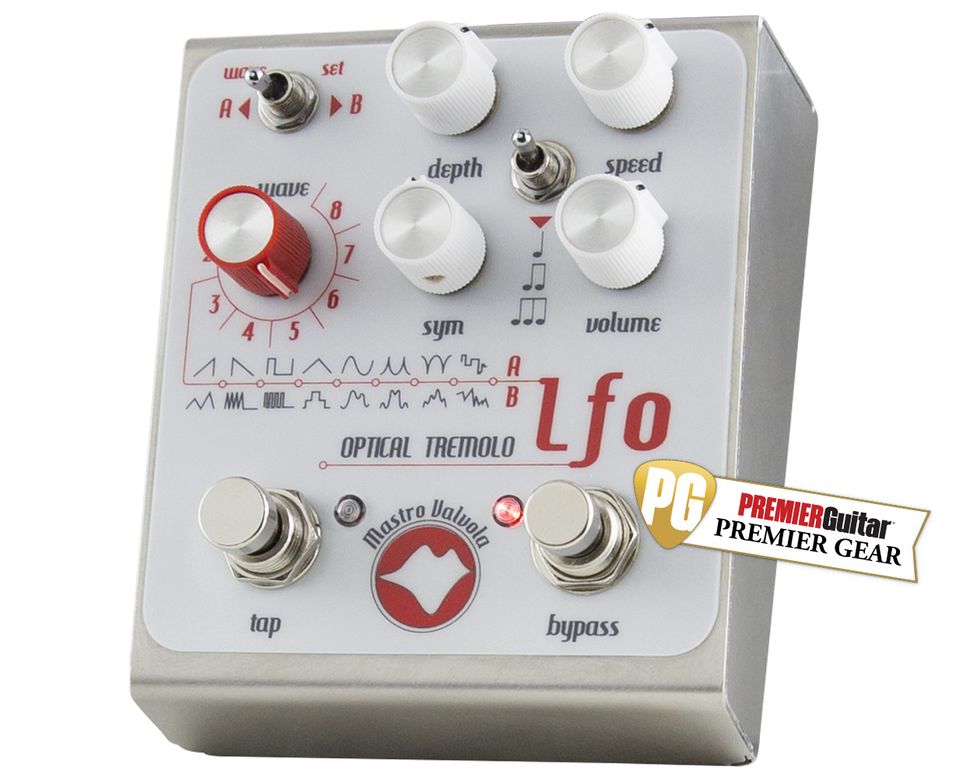RatingsPros:Great sounds from wild to mild. Extremely versatile. Feature-packed. Cons: No expression pedal functionality. Street: $249 Mastro Valvola LFO Optical Tremolo mastrovalvola.it | Tones: Ease of Use: Build/Design: Value: |
In guitar effects terms, tremolo is as old as the hills. And many of the tremolo sounds we know in our deep subconscious are derived from the optical-style circuits generated by Fender’s ’60s amps. But who says you can’t squeeze fresh blood from old photocells? With the LFO Optical Tremolo, Mastro Valvola, an Italian manufacturer with a flair for massaging the best of vintage tech into modern tools, takes an optical tremolo circuit and applies some clever tweaks and modern functionality to create a tremolo wonderland in a box.
Fundamental Futurist
The tactile experience of handling the Mastro is satisfying. The enclosure feels bulletproof, with a distinctive heft and solidity. It’s also just plain fun to hold and work with. A red, white, and raw aluminum color scheme and asymmetrical control placement give the LFO the look of a ’60s sci-fi movie prop. There’s a lot of practical design at work, too, like the top-mounted jacks, which will be appreciated by space-conscious players.
The LFO’s tidy, retro-futuristic looks aren’t just sharp. They reveal a lot about the design philosophy behind the pedal. Although an analog optical tremolo circuit is its ticking heart, a digital brain controls this device. As a result, the modulation box’s fundamental tones are classic optical tremolo—organic, warm, and satisfying at subtle and extreme settings. The basic tremolo sounds found here will leave fans of vintage Fender amps wanting for little—especially when mated to an amp with a decent effects loop.
But even through the front end of an amp, and even with thick humbuckers, the LFO can be set for a deep enough waveform to overcome saturated preamps and cut through stacks of other effects in a signal chain. Obviously, there are plenty of great analog tremolo pedals out there that do something similar for less money. But it’s the digital component of the LFO recipe that makes it extraordinary and opens up possibilities beyond classic tremolo tones.
Hang 16!
The LFO offers 16 different waveforms, many of which can be pushed well beyond typical tremolo territory into bit crusher and ring modulator mimicry at extreme speed and depth settings. The more off-kilter wave shapes also excel at goosing already distorted guitar sounds into analog synth realms. The pedal’s many waveforms can each be radically re-shaped by a symmetry knob that lets you tailor the interaction between tremolo waveforms and your signal in very specific and often radical ways. A toggle offering three different note divisions gives you even more (and more demented) wave shaping power. It also opens up even more possibilities enabled by the LFO’s invaluable tap-tempo feature. Another very functional touch is a volume knob with enough extra power to compensate for perceived volume loss, boost the front end of an amp, and turn the LFO into a much bigger sounding effect when activated.
The Verdict
The LFO is well made, loaded with smart features, and overflowing with truly wild sounds that lurk just a knob turn away from beautifully executed classic tremolo tones. Short of an expression pedal for control of speed or waveform, there is nothing keeping the LFO from joining the club of world-class modern tremolo pedals. It might, in fact, already be there.








![Rig Rundown: Russian Circles’ Mike Sullivan [2025]](https://www.premierguitar.com/media-library/youtube.jpg?id=62303631&width=1245&height=700&quality=70&coordinates=0%2C0%2C0%2C0)

















